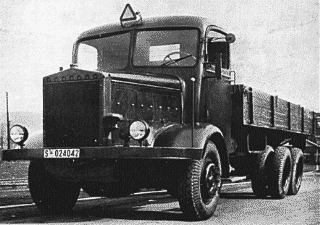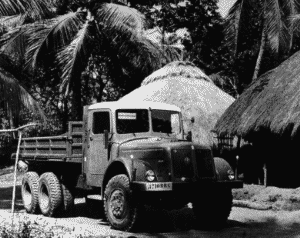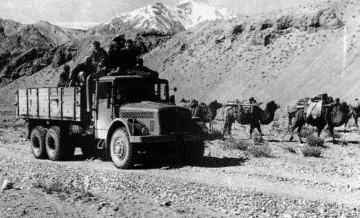
Nineteen-thirty-six (1936) brought the company yet another name change. Baron Hans von Ringhoffer, the proprietor of the Tatra works since 1923, decided to combine it with his Prague-Smichov wagon factory to create the Ringhoffer-Tatra concern. Also during that year appeared the T85 platform truck, employing a 8143cc water-cooled 4-cyl. engine and with a 4-6 ton load capacity, and stayed in production until 1938.

The T92 and T93, the former a 6x4 and the latter a 6x6, were introduced in 1937 to continue where the T72 left off. Both were powered by a 3981cc air-cooled 8-cylinder OHC engine of 74bhp output.


World War II broke out in 1939 and Tatra was forced to produce trucks for military use. That same year the massive 8-ton 6x4 T81 which utilized a 12.5-litre water-cooled 8-cylinder engine of 158bhp (either in gasoline or diesel form), had a carrying capacity of 6.5-tons, and a 65 km/h top speed.
 In 1942, as war waged on, came the introduction of the legendary T111 which was derived from the earlier T81. This imposing 6x6 truck was powered by a
massive and extremely reliable 14.8-litre V12 208bhp (@ 2250rpm) OHV engine, one of the first air-cooled diesel engines utilized in a truck. The T111 was capable of conquering 50% grades and carrying loads from 6 to 10 tons (depending on the version). Its total wheelbase measured 5.4 meters and its dry weight was 8.5 tons, but it posessed a very respectable maximum speed of 75 km/h. The T111 proved popular as 32243 sales spanned its production years from 1942 to 1961.
In 1942, as war waged on, came the introduction of the legendary T111 which was derived from the earlier T81. This imposing 6x6 truck was powered by a
massive and extremely reliable 14.8-litre V12 208bhp (@ 2250rpm) OHV engine, one of the first air-cooled diesel engines utilized in a truck. The T111 was capable of conquering 50% grades and carrying loads from 6 to 10 tons (depending on the version). Its total wheelbase measured 5.4 meters and its dry weight was 8.5 tons, but it posessed a very respectable maximum speed of 75 km/h. The T111 proved popular as 32243 sales spanned its production years from 1942 to 1961.
 T111 in Africa.
T111 in Africa.The T111 was also involved in a favourite Tatra past time, touring foreign countries and continents to prove the worth of its products. Several highly successful treks were made by T111s, across China (including Tibet), Mongolia, and Africa.
 T111 at Lhasa, Tibet. The Potala Palace is just visible.
T111 at Lhasa, Tibet. The Potala Palace is just visible.